Lecidea laboriosa Müll. Arg.
Flora, 57: 187, 1874
Synonyms: Lecidea leptoboloides Nyl.; Lecidea lithophilopsis Nyl.
Distribution:
Description: Thallus crustose, endosubstratic or very thinly episubstratic, usually poorly evident, rarely of a few, dispersed, flat, thin, white to pale grey areoles near the apothecia. Medulla I- or I+ partially and weakly blue-violet (character difficult to observe due to the poorly developed thallus). Apothecia lecideine, black also when wet, strongly constricted at base, 0.6-1.4(-4) mm across, with a concave to convex, dull, epruinose or faintly pruinose disc, and a usually persistent, dull to shiny, often more or less undulate, sometimes vertically striated proper margin. Proper exciple 30-80 µm wide laterally, black in outer part, colourless or pale purplish brown within, the medullary part with crystals dissolving in K, C-; epithecium dark green, green-black or rarely dirty brown, 8-14 µm high, N+ purple-red; hymenium colourless or more rarely with a pale violet tinge in marginal parts, 37-65 µm high, I+ blue; paraphyses simple, rarely branched, the apical cells 3.5-5 µm wide, globose, with dark caps; subhymenium colourless 25-50 µm high; hypothecium colourless to rarely pale brown, 40-90 µm high. Asci 8-spored, narrowly clavate, thick-walled, with a K/I+ pale blue tholus and a strongly amyloid, thin apical cushion, surrounded by a I+ blue outer layer, Lecidea-type. Ascospores 1-celled, hyaline, oblong-ellipsoid, (6-)8-12(-16) x (2-)2.5-3 µm, 2.3-3.7 times as long as wide. Pycnidia graphidioid, immersed in tiny whitish areoles. Conidia cylindrical, (6-)8.4-12.3(-16) x 1-1.3 µm. Photobiont chlorococcoid. Spot tests: cortex and medulla K-, C-, KC-, P-. Chemistry: 4-O-demethylplanaic acid, sometimes with traces of planaic acid, or (more rarely) without lichen substances.Note: a still insufficiently known species of the L. plana-group with narrower ascospores, found on siliceous rocks, usually at high elevations; European distribution poorly documented, with a few records from the Central Alps outside the Italian territory; to be looked for in the Italian Alps. According to Hertel (1999), most specimens identified as L. paratropoides, when chemically analyzed, will probably turn out to be L. laboriosa.
Growth form: Crustose endolithic
Substrata: rocks
Photobiont: green algae other than Trentepohlia
Reproductive strategy: mainly sexual
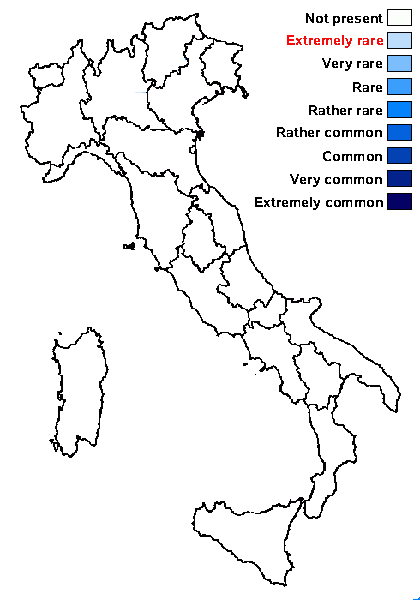
Predictive model
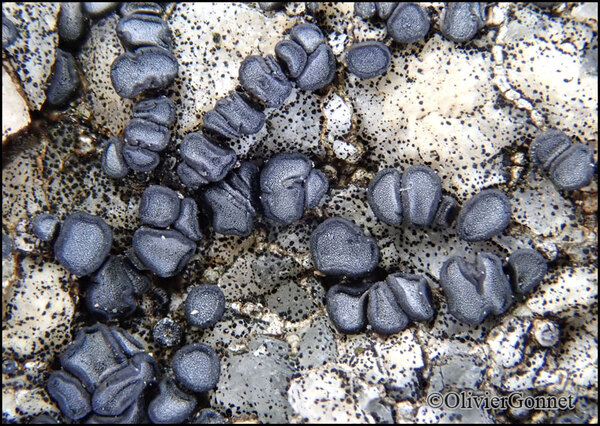
Courtesy Danièle et Olivier Gonnet - Source: https://www.afl-lichenologie.fr/Photos_AFL/Photos_AFL_L/Texte_L_4/Lecidea_laboriosa.htm
France, Ajaccio, campo dell’ Oro, alt. 5 m - Corse - (20) - sur rocher granitique, dét. avec l'aide de Michel Bertrand, conf. avec une CCM de Philippe Uriac
9/10/2018

Courtesy Danièle et Olivier Gonnet - Source: https://www.afl-lichenologie.fr/Photos_AFL/Photos_AFL_L/Texte_L_4/Lecidea_laboriosa.htm
France, Ajaccio, campo dell’ Oro, alt. 5 m - Corse - (20) - sur rocher granitique, dét. avec l'aide de Michel Bertrand, conf. avec une CCM de Philippe Uriac
9/10/2018
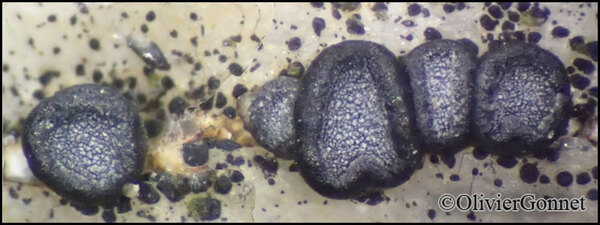
Courtesy Danièle et Olivier Gonnet - Source: https://www.afl-lichenologie.fr/Photos_AFL/Photos_AFL_L/Texte_L_4/Lecidea_laboriosa.htm
France, Ajaccio, campo dell’ Oro, alt. 5 m - Corse - (20) - sur rocher granitique, dét. avec l'aide de Michel Bertrand, conf. avec une CCM de Philippe Uriac
9/10/2018
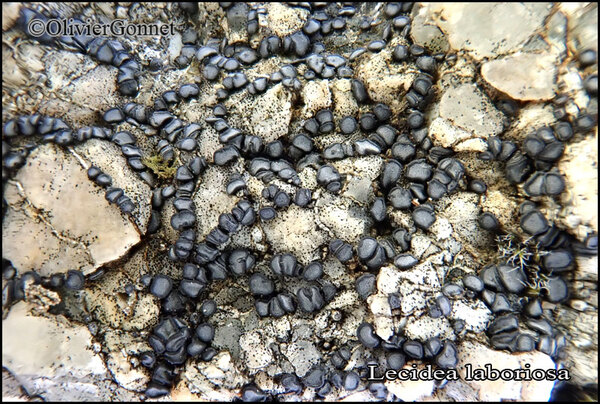
Courtesy Danièle et Olivier Gonnet - Source: https://www.afl-lichenologie.fr/Photos_AFL/Photos_AFL_L/Texte_L_4/Lecidea_laboriosa.htm
France, Ajaccio, campo dell’ Oro, alt. 5 m - Corse - (20) - sur rocher granitique, dét. avec l'aide de Michel Bertrand, conf. avec une CCM de Philippe Uriac
9/10/2018
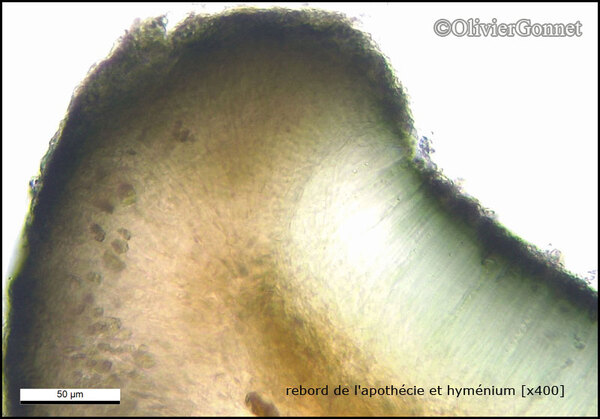
Courtesy Danièle et Olivier Gonnet - Source: https://www.afl-lichenologie.fr/Photos_AFL/Photos_AFL_L/Texte_L_4/Lecidea_laboriosa.htm
France, Ajaccio, campo dell’ Oro, alt. 5 m - Corse - (20) - sur rocher granitique, dét. avec l'aide de Michel Bertrand, conf. avec une CCM de Philippe Uriac
9/10/2018
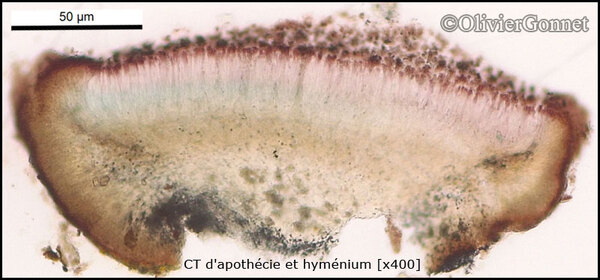
Courtesy Danièle et Olivier Gonnet - Source: https://www.afl-lichenologie.fr/Photos_AFL/Photos_AFL_L/Texte_L_4/Lecidea_laboriosa.htm
France, Ajaccio, campo dell’ Oro, alt. 5 m - Corse - (20) - sur rocher granitique, dét. avec l'aide de Michel Bertrand, conf. avec une CCM de Philippe Uriac
9/10/2018

Courtesy Danièle et Olivier Gonnet - Source: https://www.afl-lichenologie.fr/Photos_AFL/Photos_AFL_L/Texte_L_4/Lecidea_laboriosa.htm
France, Ajaccio, campo dell’ Oro, alt. 5 m - Corse - (20) - sur rocher granitique, dét. avec l'aide de Michel Bertrand, conf. avec une CCM de Philippe Uriac
9/10/2018

Jason Hollinger - POublic Domain - Source: https://lichenportal.org/cnalh/taxa/index.php?taxon=54116&clid=1081
USA, Idaho
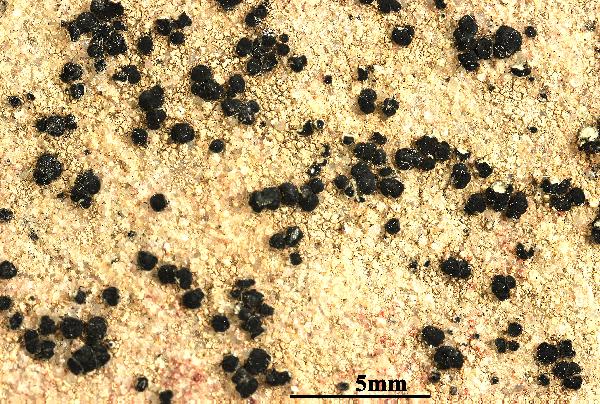

Felix Schumm - CC BY-SA 4.0
[16790], USA, Arizona, Gila County, On sandstone, conifer-oak forest
with expansive sandstone outcrops, ca. 1 mile south of Baker Lake,
south of AZ Route #87, along Coconino-Gila County Border, Tonto
National Forest, 34°26'26'' N, 111°23'59'' W, 7200 ft. Leg. J. C. Lendemer
(no2726), 1 Aug 200, det. J. Lendemer 2004.
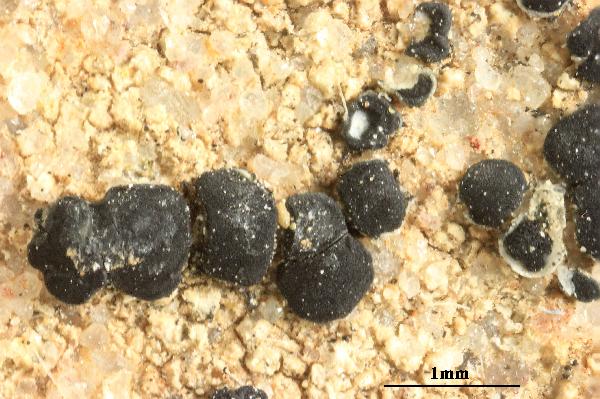

Felix Schumm - CC BY-SA 4.0
[16790], USA, Arizona, Gila County, On sandstone, conifer-oak forest
with expansive sandstone outcrops, ca. 1 mile south of Baker Lake,
south of AZ Route #87, along Coconino-Gila County Border, Tonto
National Forest, 34°26'26'' N, 111°23'59'' W, 7200 ft. Leg. J. C. Lendemer
(no2726), 1 Aug 200, det. J. Lendemer 2004.
Growth form: Crustose endolithic
Substrata: rocks
Photobiont: green algae other than Trentepohlia
Reproductive strategy: mainly sexual

Predictive model

Courtesy Danièle et Olivier Gonnet - Source: https://www.afl-lichenologie.fr/Photos_AFL/Photos_AFL_L/Texte_L_4/Lecidea_laboriosa.htm
France, Ajaccio, campo dell’ Oro, alt. 5 m - Corse - (20) - sur rocher granitique, dét. avec l'aide de Michel Bertrand, conf. avec une CCM de Philippe Uriac
9/10/2018

Courtesy Danièle et Olivier Gonnet - Source: https://www.afl-lichenologie.fr/Photos_AFL/Photos_AFL_L/Texte_L_4/Lecidea_laboriosa.htm
France, Ajaccio, campo dell’ Oro, alt. 5 m - Corse - (20) - sur rocher granitique, dét. avec l'aide de Michel Bertrand, conf. avec une CCM de Philippe Uriac
9/10/2018

Courtesy Danièle et Olivier Gonnet - Source: https://www.afl-lichenologie.fr/Photos_AFL/Photos_AFL_L/Texte_L_4/Lecidea_laboriosa.htm
France, Ajaccio, campo dell’ Oro, alt. 5 m - Corse - (20) - sur rocher granitique, dét. avec l'aide de Michel Bertrand, conf. avec une CCM de Philippe Uriac
9/10/2018

Courtesy Danièle et Olivier Gonnet - Source: https://www.afl-lichenologie.fr/Photos_AFL/Photos_AFL_L/Texte_L_4/Lecidea_laboriosa.htm
France, Ajaccio, campo dell’ Oro, alt. 5 m - Corse - (20) - sur rocher granitique, dét. avec l'aide de Michel Bertrand, conf. avec une CCM de Philippe Uriac
9/10/2018

Courtesy Danièle et Olivier Gonnet - Source: https://www.afl-lichenologie.fr/Photos_AFL/Photos_AFL_L/Texte_L_4/Lecidea_laboriosa.htm
France, Ajaccio, campo dell’ Oro, alt. 5 m - Corse - (20) - sur rocher granitique, dét. avec l'aide de Michel Bertrand, conf. avec une CCM de Philippe Uriac
9/10/2018

Courtesy Danièle et Olivier Gonnet - Source: https://www.afl-lichenologie.fr/Photos_AFL/Photos_AFL_L/Texte_L_4/Lecidea_laboriosa.htm
France, Ajaccio, campo dell’ Oro, alt. 5 m - Corse - (20) - sur rocher granitique, dét. avec l'aide de Michel Bertrand, conf. avec une CCM de Philippe Uriac
9/10/2018

Courtesy Danièle et Olivier Gonnet - Source: https://www.afl-lichenologie.fr/Photos_AFL/Photos_AFL_L/Texte_L_4/Lecidea_laboriosa.htm
France, Ajaccio, campo dell’ Oro, alt. 5 m - Corse - (20) - sur rocher granitique, dét. avec l'aide de Michel Bertrand, conf. avec une CCM de Philippe Uriac
9/10/2018

Jason Hollinger - POublic Domain - Source: https://lichenportal.org/cnalh/taxa/index.php?taxon=54116&clid=1081
USA, Idaho


Felix Schumm - CC BY-SA 4.0
[16790], USA, Arizona, Gila County, On sandstone, conifer-oak forest with expansive sandstone outcrops, ca. 1 mile south of Baker Lake, south of AZ Route #87, along Coconino-Gila County Border, Tonto National Forest, 34°26'26'' N, 111°23'59'' W, 7200 ft. Leg. J. C. Lendemer (no2726), 1 Aug 200, det. J. Lendemer 2004.


 INDEX FUNGORUM
INDEX FUNGORUM
 GBIF
GBIF

